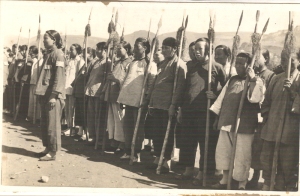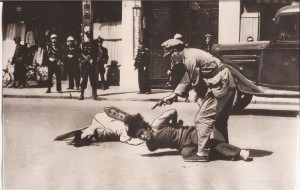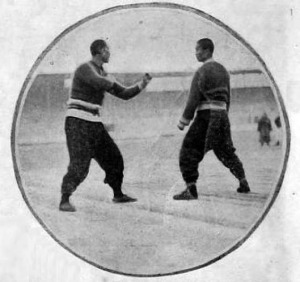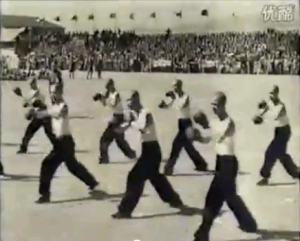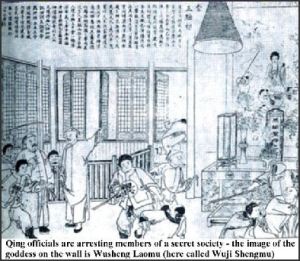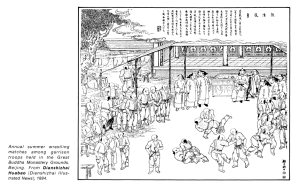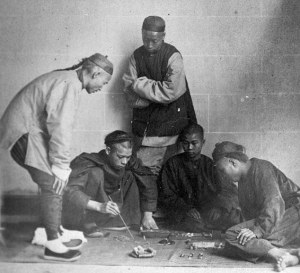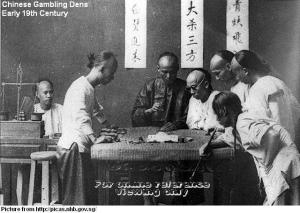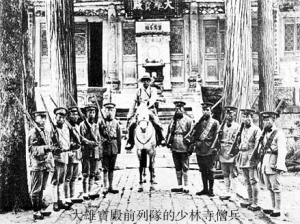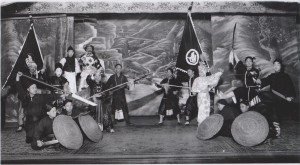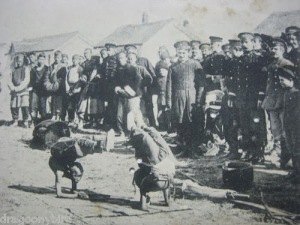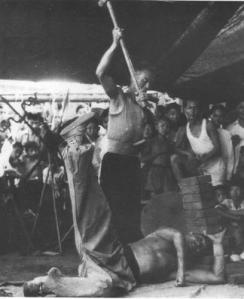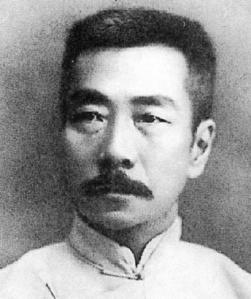Chinese martial arts can never truly escape history and politics. The term “Wu Shu” (武術) has been avoided by most traditional Chinese martial artists because of its association with the contemporary Wu Shu movement based in Mainland China. While the initial movement was based upon traditional teachings and in many ways similar to the Kuoshu (國術) program the Nationalists (KMT) had engaged in during the Republican period, the contemporary Wu Shu movement’s association with Communism was enough reason for many to avoid the term. As contemporary Wu Shu became more and more performance based, it indeed merited some differentiation.

For our purposes, we will put aside these more modern issues and remember that “Wu Shu” (武術) as a term meaning “martial arts” first appeared in the early sixth century during the Liang Dynasty (502-557 CE) (Lorge p 10). It also appears later in Ming Dynasty sources. It is instructive to remember that the character “Wu” (武) means “military” and that the character “Shu” (術) can mean “skill”, “method” or “tactic”. The term “martial arts” unfortunately for many has some preconceived baggage attached to it, but discussing “military skills”, “military methods” and/or “military tactics” brings us more quickly to the reality of the matter. “Wu Shu” (武術) in China has been subject to both internal and external forces and has responded to those forces in a myriad of ways, but when we speak of origins, we must never forget that originally “martial arts” were military skills with practical application in warfare.

As Peter A. Lorge so eloquently states, “these arts are the developed physical practices of armed and unarmed combat, which must be understood primarily as military skills.” (Lorge p i). The idea that Buddhist monks, Shaolin or otherwise, and Daoist priests, Wudang or otherwise, had any major role in the origins of Chinese martial arts is a popular fiction but has no basis in reality. That is not to say there were no martial arts at Shaolin or other Buddhist monasteries. Buddhist monks and Daoist priests, just like the rest of Chinese society, acquired for their own particular use existing military skills that had been developed and used on the battlefield. Martial arts were widespread throughout general society, most frequently spread by men who had been trained in the military and then returned to regular life.

The “Book of Rites” dating from the Zhou dynasty (1046 BC–256 BC) refers to “Jiao Li” (角力), a form of combat wrestling. The “Han Dynasty Historical Bibliographies” indicate that by the Former Han period (206 BCE – 8 CE), “Shou Bo” (手搏) or empty hand methods differentiated from wrestling (i.e. striking) and specifically for combat as opposed to sport, had been practiced and developed to the point that training manuals had been published. “Shou Bo” is categorized as one of the four military skills under the major heading “Military Writings”. Based on the bibliographical listing; these four military skills included archery, fencing, “Shou Bo”, and an ancient game of football (“Cu Ju” 蹴鞠) for agility.

That certain wrestling, kicking and striking tactics accompanied military training in weaponry should be of no surprise to anyone with even a passing knowledge of military history. However, they must be understood as ancillary to such battlefield and weapon training. The Han bibliographies describe “Shou Bo” as training “to practice hand and foot movements, facilitate the use of weapons, and organize for victory in offense or defense”. In other words, their role was as a foundation for developing weapons skills such as sword and polled weapons such as the spear and halberd.

Even during the Ming Dynasty, as empty hand fighting traditions flourished, General Qi Jiguang’s “New Book on Military Efficiency” relegated empty hand training to helping conscripts become strong and confident soldiers. General Qi’s introduction stated “the fist methods do not seem to concern themselves with the arts of great warfare; nevertheless, to move the hands and feet actively and to work habitually the limbs and body constitutes the gateway to beginning study and entering the art”. The discussion of empty hand training was even removed from some editions, perhaps due to fears that their proper role would not be understood.

While records differentiating specific empty hand methods may be fascinating for the modern martial artist, in the larger picture we must still understand that the traditions we have inherited originated as military training. They only later evolved into what we now understand as martial arts as they filtered into the general population. Until approximately the Ming Dynasty, when empty hand training flourished and distinct methods emerged, the history of Chinese martial arts is inseparable from Chinese military history.
The Waring States Period was characterized by widespread conflict which had militarized the whole population. In the absence of professional armies, civilians were trained in military methods, experienced combat first hand, and then returned home with this experience and skills. Men experienced and skilled in violence were numerous and others could acquire from them similar training. It was a reality that could not be easily reversed, and subsequent dynasties failed to learn the lessons of the Waring States Period.
The Waring States Period had introduced the sword into warfare, and under the Qin it became a favorite weapon. With the sword came “Knights-errant”, men with martial skills who were not bound to a single authority. In their best light, they were seen as men who used violence to avenge wrongs and insults. In more common practice, they were mercenaries and assassins without restraints whose skills could be bought. The second legacy of the Waring States Period was the establishment of a sub-culture based upon skill in violence.

The Qin dynasty, despite its relatively short reign, introduced the ideas of centralization that characterized the Imperial period of Chinese history. The Qin introduced a professional army with career generals, and the military became a new profession with new opportunities. Men sought training in martial arts in order to make a living as a professional soldier. Other men were able to establish themselves as trainers in these skills, able to be hired by those seeking advancement. This became particularly true with the establishment of the military examination system.

Although there were imperial exams as early as the Han dynasty, the examination system became the major path to career advancement only in the mid-Tang dynasty. Specialized military exams for the selection of army officers were held at the local, provincial and national levels. Military candidates were expected to be familiar with the same Confucian texts as civil examination candidates, plus military texts such as Sun Tzu. Then, of course, there were demonstrations of martial skills and of physical strength.

As should be expected, horsemanship and archery were of great importance during military exams. The local exams were administered by district magistrates and required the candidates to shoot three arrows while riding a horse past a target in the shape of a person. A perfect score was three successful hits, a good score two hits, and one hit earned a pass. The candidate failed if he made no hits or fell from his horse. These aspects of the military exams remained relatively constant over time. However, during the Ming Dynasty, a critical time in the emergence and development of the empty hand systems, we know that candidates were tested on skills more familiar to modern martial artists; the spear, straight sword, saber, and unarmed combat.

It is worth noting that as the candidate advanced, there was a greater importance attributed to demonstrations of physical strength. The national exams, conducted in the presence of the emperor, included bending the 120-catty bow, maneuvering the 120-catty halberd and lifting 300-catty weights (one catty equals 1.1023 pounds). Since, the Waring States Period, demonstrations of physical strength were believed to have a direct relationship with martial prowess and this belief would continue for most of Chinese martial arts history. There is a definite logic to this; stronger men have advantages in wrestling and striking, could better bear the wearing of armor, and could even shoot arrows farther. We should reconsider this when we turn our attention to the so-called “internal” schools (Nei Jia Quan) that appear in the Qing Dynasty.

Let us for a moment turn our attention to the general Yue Fei (1103–1141 CE). A famous and respected historical figure, Yue Fei he has also been attributed as the founder of several martial arts including Xingyi Quan, Eagle Claw and Yue Jia Quan. There is virtually no reliable evidence linking him to these or any other empty hand martial art, but that several traditions have claimed him should be no surprise at all. Foundation myths cannot be taken as literal history, but they are instructive in what they suggest; how these martial artists viewed themselves, who they wanted to be associated with, and as a reflection of their own experiences.
Yue Fei’s biography provides us with both some solid historical facts while also suggesting less directly the relationship between military training and civilian martial arts practice. The Chronicle of Yue (宋岳鄂王年譜) says that despite being literate, young Yue Fei chose the military path because there had never been any tradition of full-fledged Confucian civil service in his family history. The boy’s maternal grandfather paid for his military training by hiring Chen Guang (陳廣) to teach the eleven-year-old how to wield the Chinese spear. Then a local knight-errant named Zhou Tong (周同) was brought in to continue Yue’s military training in archery and military tactics after he had quickly mastered the spear by the age of thirteen.
In preparing for a military career, we see that Yue Fei trained first as a civilian by hiring private, independent martial arts instructors. By this period, it appears that this was already a common practice and there were many such instructors available for hire. Yue Fei’s biography does not mention him learning empty hand martial arts as a child, but martial researcher Stanley Henning states “[Yue] almost certainly did practice some form of bare handed fighting as a basic foundation for use of weapons.”

The classical biography also refers to his second instructor, Zhou Tong, as a “knight-errant” with all the potential baggage such a title entailed. Compare this with later martial arts traditions, which have attempted to link Zhou Tong to the fabled Shaolin temple. Lily Lau has stated that “Ngok Fei (sic) inherited this set of techniques from Chow Tong (sic) in (sic) Shaolin”. Shum Leung’s book The Secrets of Eagle Claw Kung Fu not only links Zhou Tong to Shaolin but explicitly states that Yue Fei studied in the temple; “… the Shaolin Monastery where Ngok Fei (sic) had studied with Jow Tong (sic) years before”. This is a familiar tactic in Qing dynasty martial arts circles, to claim affiliation with a respected, perhaps famous, figure and also engage in a bit of creative historical revision to clean up any possible conflicts in the quest to legitimate these emerging traditions.
Chinese martial arts originated in the military, and during all time periods soldiers, former soldiers and militia constituted the vast majority of its practitioners. Martial artists identified with and wanted to be associated with the famous and respected general. Meir Shahar notes that mention of Yue Fei in the second preface to the “Sinew Changing Classic” published in 1624 “spurred a wave of allusions to the patriotic hero in later military literature”. As he reemerged in the public’s awareness, it is natural that many would claim association. Shahar continues, “By the eighteenth century, Yue Fei had been credited with the inventions of Xingyi Quan”.

Competition to claim Yue Fei as part of one’s linage evolved in predictable ways. While it wasn’t possible to disprove that Yue Fei may have created Eagle Claw, it was just as easily possible to claim that it was training only for his enlisted soldiers. The so-called “internal school” could claim that Yue Fei’s officers learned his more refined art, Xingyi Quan! Say anything often enough and for many it becomes “fact”, Yang Jwing Ming has repeated in several forums that “Yue, Fei created for his troops two new styles. The first, which he created out of external, was Eagle Claw”.
However, a more careful reading of the various martial arts legends suggests an even more tantalizing possibility; a common ancestor! According to the Eagle Claw tradition, the original 108 Qin Na tactics (一百零八擒拿) derive almost directly from the Zhou Tong method which was called “Elephant Stepping”. Unlike the contemporary Eagle Claw, it was generally devoid of high kicks or acrobatics. As the name perhaps suggests, it was an aggressive method with firm, rooted stepping. In this context, reading what the system was supposed to have appeared like in its original form, it does not seem that far afield of the Xingyi Quan method. All of which is to say, they could have theoretically descended from the same method, thought it remains highly unlikely that method was at all linked to Yue Fei!


